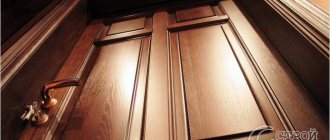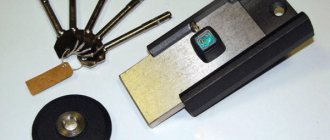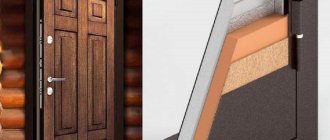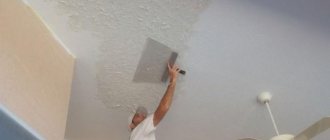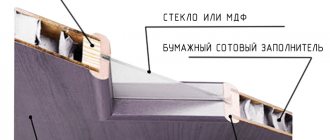Miscellaneous
Over time, swing doors undergo deformation, and then the question arises of how to cut the interior door to height. This need appears as a result of subsidence, swelling (in the case of a wooden door leaf), or a change in floor level. After laying laminate or other new flooring on top of the old one, you also need to shorten the interior doors.
Depending on what exactly the door is made of, the methods vary. The most questions arise with veneered models. This kind of fabric is heterogeneous, and the veneer itself is quite easy to damage when sawing. However, even such doors can be shortened, although it will take more time.
Note that it is important to take into account the device itself: hollow products cannot be cut off by more than 1 centimeter.
Example of a hollow door
Is it possible to trim an interior door?
There are several designs of interior doors, and each requires its own approach. Quite often a lightweight, hollow sheet is installed. It consists of a frame (frame) and filling, and the top is lined with fiberboard or other material. If the supporting frame is damaged, the strength of the structure is reduced and it may become deformed. It is not recommended to cut such a fabric from any side. In case of urgent need, you can trim it only slightly - no more than 1 cm. If the door is monolithic and assembled from solid slabs, then almost any trimming is allowed on all sides.
Another problem. Doors can be panel (smooth), completely recessed in the doorway, or with an overlap. In the latter case, an edge is formed at the edges of the canvas, which does not go into the opening, but closes the gaps between the door and the wall or floor. Smooth doors are quite amenable to trimming, but in the second option everything depends on the width of the edge.
Finally, decorated doors can have a specific pattern. Trimming can change the symmetry, reducing the appearance. This factor should be taken into account when planning work.
Width and height reduction technology
All doors are completely different, as are the openings where they are installed. Based on this, there are many cases that are not similar to each other. Sometimes it takes a few minutes to cut a wooden door, while the same situation can take a whole day. Everything directly depends on the size.
For example, reducing a door leaf to 0.5 cm does not require many tools. The standing beams are shortened with a circular saw or jigsaw. If the question concerns 0.5-1 cm, the canvas will have to be planed and sawed additionally. It is also advisable to chamfer the edges to obtain rounded ends. This sanding is usually done by hand, but using a plastic float is not a mistake.
When it comes to greater width or height, you cannot do without specialized glue to strengthen the structure. Having removed the excess honeycombs, it is advisable to insert the end of the frame into the canvas. To secure it, use staples and then glue or regular masking tape. The procedure must be carried out with safety glasses, since the cutting elements of the fastening (staples) can get into the eye.
It is necessary to remember: if the part is paneled (has inserts), then cutting is done on both sides. Otherwise, the symmetry of the drawing will be irrevocably broken. When cutting the canvas, it is important not to damage the coating or lining. If you stick self-adhesive tape along the cutting line, you can achieve minimal damage to the front surfaces. Professionals also often use the incision technique - it avoids harming the material. After trimming, the edge must be cleaned with a plane inward. For polishing, use a sanding iron, which will help to work out small elements of complex geometric shapes.
Thus, when cutting interior door in height and width, it is better to spend 2-4 hours on it, and also set aside a day for the glue to dry. If you use adhesive tape, you can use the opening almost immediately. The main thing is to choose high-quality materials that will guarantee the wear resistance and durability of the cut unit. If you can’t complete the procedure yourself, you can always turn to experts for help.
Preparation of materials and tools
To change the size of the door leaf you will need the following tool:
- Cutting tool. Depending on the door material and the degree of shortening, the following are used: a hacksaw, a hacksaw for metal (suitable for plastic), an angle grinder, a plane, a router, a circular saw, and a jigsaw.
- Clamp. It is necessary to secure the canvas during work.
- Hand tools for finishing: carpenter's knife, chisel, files, hammer, screwdriver, punch.
- Sandpaper for finishing.
- Measuring tools: tape measure, metal ruler, square.
Depending on the design of the door and coating, you should prepare the following consumables in advance:
- Glue - PVA, carpentry, epoxy, special glue D2 for wood, “Moment” or other varieties.
- Wooden blocks and slats of different sizes.
- Masking tape and metal guides to guide the cutting tool.
To restore the outer covering of the canvas at the cutting site, you will need varnish, veneer, edge tape and other materials. You can correct errors and minor defects using putty.
Advice from professionals
A panel made of solid wood or MDF can be cut from the bottom if it does not have panels or their imitation. If there is a symmetrical decor, it is better to trim on both sides, dividing the size of the cut part by 2. These measurements are set aside from each edge, without disturbing the symmetry of the top and bottom panels. Do the same if you need to reduce the standard width of the door leaf.
Hollow frame doors should not be shortened too much. The product consists of wooden blocks of limited thickness. When performing work, you need to leave at least 1-1.5 cm of the frame bar inside the canvas. You can shorten the door as indicated for the design with panels - at the top and bottom.
When trying to install a standard door in a small opening, the molded frame materials are shortened to measure and secured in the opening. The dimensions of the sash will have to be adjusted using the technology described above.
Solid wood canvas sometimes swells due to excess moisture and does not fit well into the frame. This problem can be eliminated with a plane or a grinder (hand router). Remove the blade, place it on a workbench and process its edge with a cutting tool, removing a few millimeters of chips from the desired side. Hang the door and test its movement. If the problem is not resolved, repeat the treatment.
To get an even cut of an array when using a circular saw, you will need a disk with a large number of small teeth. But even under this condition, it will not be possible to cut the veneered product efficiently. For MDF panels, it is better to use a jigsaw, and carry out the work in compliance with the rules protecting the veneer layer (sticking tape, cutting through the veneer).
If it is possible to use a manual router, then you should only choose it for the job. The tool will make an even and clear cut, and the cutting line will not have to be processed additionally either on a massive product, or on MDF or a frame model.
To properly apply the edge tape, use PVA glue and an iron. The adhesive layer must be applied to the cut of the canvas and allowed to dry. Place the tape on the edge of the door and iron it through the paper with a hot iron. After cooling, cut off the excess tape with a sharp knife and lightly rub the edges with sandpaper.
Preparing the canvas for work
Before starting actual cutting, it is necessary to carry out the following preparatory work:
- Remove the fabric from the hinges and free it from the fittings (handles, hinges, other protruding elements).
- Place the canvas on a workbench or flat area (table), securing it with clamps. It is necessary to ensure complete immobility.
- The doorway and leaf are carefully measured to determine the optimal cutting location and the degree of shortening. Marking is being done.
- The place for the cutting tool to work is being prepared. When working with a circular (circular) saw, a board is secured below the cut point. If a grinder is used, it is recommended to provide a stop on both sides of the cutting line.
- If there is veneer, it is carefully cut with a knife along the guides. If there is a varnish coating, then to prevent it from cracking along the cutting line, the varnish is removed with sandpaper.
Complete preparation of the blade will facilitate the cutting process and improve quality.
How to cut a panel door with fiberboard panels
Panel or frame-honeycomb doors with leafs or fiberboard overlays are the best solution when replacing only the door leaf (hanging the leaf on an old door frame), also for installing doors in unusual door openings in walls and partitions. By unusual, I mean openings less than 2.03 m high and less than 68 cm wide, which is not so uncommon in private houses, “Khrushchev” buildings, panel, block and brick houses with cement screed or gypsum panels on the floor.
Completely replacing a door is time-consuming, expensive, noisy and dirty. Especially if you have to expand the door clearance. In houses with brick or block walls and partitions, in order to increase the height of the doorway, new lintels will have to be installed in advance. In panel houses, some residents destroy the upper part of the reinforced concrete panels of the load-bearing walls. Not that this greatly reduces the load-bearing capacity of the walls, but there is enough noise and dust during all this. In terms of time, installing a door in such a gap can take up to 2 weeks, taking into account the sealing of the slopes. The cost of installation (without the price of the door) can be up to $200-300.
In such cases, it is most rational to use primed panel doors with fiberboard linings. This door leaf can be purchased for $15-20. After trimming and additional processing, the canvas is painted and in appearance is practically no different from ordinary canvas.
The panel door system with fiberboard overlays allows you to cut the door leaf from the top, bottom or side quite quickly, simply and without actually harming the appearance.
How does the cut size affect?
The cutting technology and the cutting tool used depend on the size of the strip being cut.
- To shorten the canvas by 0.5 cm or less, professionals use a jointer or electric jointer, but at home they are rarely available. You can use a regular plane (jointer). When reducing the height, an electric jigsaw or a hacksaw with fine teeth is often used. Finally, the end is polished
- When the cut size is within 0.5–1 cm, a hand-held circular saw is used. When cutting with a jigsaw or hacksaw, the cut is uneven, which requires subsequent planing. This circumstance should be taken into account when cutting, taking a reserve for planing.
- Reducing the dimensions of the hollow (frame) fabric by 1–3 cm requires preliminary reinforcement of the structure. You will have to partially disassemble the canvas at the cutting site and install reinforcing bars, securing it with glue or staples. The cutting itself can be carried out with the same tools as in the previous case.
- When cutting the frame strip by 3–5 cm or more, reinforcement of the frame is necessary. The width of the rack is restored with the help of an additional beam, which is firmly fastened to the remains of the previous structure and connected to the perpendicular elements. The new design is carefully reinforced with glue. The excess fiberboard strip is sawed off with a hacksaw or jigsaw. A chamfer is cut at the ends of the fiberboard. The area where the blade is cut is sanded.
We shorten the door
Before completing the work, it is necessary to remove the canvas from its hinges. Initially, the handle and other fittings are removed. The height of the door leaf is trimmed on a workbench. If this item is not available, then you can use a stable table. Many people are interested in how to trim a door from below with their own hands? The panel, made of solid wood, will have to be adjusted to the opening due to the rise of the floor. As a rule, the door is trimmed from the bottom. Then 2 height measurements are taken: at the hinges and in the vestibule.
The measurements taken will have to be transferred to the door leaf. It is recommended to start the new size from the top edge. A straight line is drawn through 2 points. To perform this action you will need a long ruler along with a square. In this way, it is possible to control right angles between edges.
The guide rail is attached according to the applied markings. How to shorten a door using a power tool? If you use a special power tool, then you can trim the door leaf with precision.
How to carefully and efficiently cut interior veneer doors?
How to shorten an interior door with your own hands at home? To preserve the layer of varnish and veneer on a polished door, you must use a grinder. Using the tool disk, you can leave a cut with smooth edges. They cannot be obtained using a saw. When processing the edges, you need to stick the tape in advance. If you don’t have a grinder, you will have to use sandpaper to remove the varnish coating on the area to be removed. Use a sharp knife to cut through the veneer. This way you can saw off the door leaf along the guide.
From below
If the need to change the size of the canvas is caused by an increase in the level of the floor covering, then the best option is to trim the door from the bottom. It is carried out in the following order:
- The cut is marked using a metal ruler and a square. The sizes are attached to the loops. A straight cutting line is drawn.
- Guides are installed slightly above the drawn line. They are secured with clamps or masking tape. Power tools require metal runners, while hand tools also require wooden slats.
- Using the required cutting tool, a strip of the door leaf is cut along the marked line.
- If the edge of the cut has unevenness, then planing is done using a plane.
- The guides are removed, and the cut area is treated with sandpaper.
After trimming is completed, the coating of the canvas is restored. When covering with veneer, a strip of veneer of the appropriate structure and color is glued to the bottom. PVC glue and iron are used. The excess is cut off with a knife. Using a brush, the varnish or paint coating is restored.
Belt sander
When using a belt sander, high rotation speed must be taken into account, so perform the work carefully. Before you begin, check that the sanding belt is properly aligned - turn the tensioner knob so that the belt runs in a straight line over the support surface. Move the machine evenly over the surface. The machine sands very quickly, and if you are not careful, uneven sanding marks will appear on the wood. When sanding the door, it is best to use a 40-grit coarse sanding belt.
Above
Such shortening is usually carried out in conjunction with lower trimming when it is necessary to maintain the symmetry of the pattern or when cutting a hollow web by more than 1 cm. The cutting procedure itself is practically no different from the previous technology.
It is important to ensure that the dimensions of the cut strip from the bottom and top match exactly. The difference between top and bottom trimming is related to the appearance of the canvas. Any defects in the upper part are more noticeable, and therefore it is especially important to ensure the evenness of the cut line. This requires careful planing and grinding.
Gluing veneer to a finished door
Although the procedure is simple, you should master some skills. There are several ways to glue veneer to a finished door.
Cold contact method
It is considered the most difficult method of gluing wood to a treated surface. Involves the use of contact adhesive. The difficulty is that the binder sets quickly. This will make it extremely difficult to correct inaccuracies when mating surfaces are placed incorrectly.
In order for the gluing to be reliable, it is necessary to create a strong pressing force in the first seconds of contact between the materials (press with your hand or a weight). Experts do not recommend using it for gluing large surfaces.
Hot gluing
A layer of glue is applied to the surfaces to be glued, which must dry for a certain period of time. After this, it is necessary to attach a sheet of veneer exactly to the dimensions. Using an iron, the sheet begins to be smoothed from the center to the edges. The adhesive composition melts under the influence of high temperature and glues the two materials together. For the contact hot gluing method to work, it is necessary to use an adhesive with a thick consistency. To prevent the glue from drying out too quickly when using an iron, you need to moisten the veneer surface with warm water. In places where there are swellings, punctures or cuts must be made to release the air.
Cold gluing with pressing
A classic gluing method that requires securing clamps to the glued surfaces. The holding time is indicated on the packaging of the composition used. After drying, it is necessary to remove the clamps and check the condition of the door ends.
Useful tips and tricks
- When using veneer made from expensive wood species (oak, ash), it is necessary to apply a layer of cotton fabric to the canvas.
- The new surface can only be sanded along the grain with sandpaper.
- Since the new coating absorbs water well, immediately after gluing it must be covered with a layer of varnish.
- When using an iron, you need to constantly move it across the work surface. It is forbidden to hold a heated metal surface in one place. If scorching occurs, it is necessary to remove the blackness with a sharp knife or blade.
- To secure a long strip of veneer to an edge, you need to secure one of the edges using an iron or hair dryer. It is convenient to use a soldering iron to secure edges and corners.
- Covering radius doors should be entrusted to old furniture veneerers.
- Joint veneer panels made from different types of wood look unusual.
- At the ends located at the bottom and top of the blade, it is necessary to cut off 2 mm chamfers on both sides. The sash will not cling to the frame after gluing the new wooden covering.
- When cutting a sheet with a knife, it is recommended to do so across the grain. If the sheet is cut lengthwise, it is necessary to make several movements with the blade. Otherwise, the cutting part of the knife will slip and ruin the sheet.
By following the basic rules, you can carry out the work without difficulty.
Trimming the door to width
The need to trim to width arises when the dimensions of the doorway and the door leaf do not match, which occurs when replacing a door or remodeling a room. It is carried out in the following order:
- The canvas is removed from the hinges and secured to the workbench with clamps.
- Marking is carried out taking into account important conditions. A gap of about 6 mm is left on the hinge side. The fabric sample is made from the side opposite to the loops. The cut line must be strictly parallel to the inner edge of the door.
- Secure the metal guides using masking tape and clamps.
- Trimming the canvas. It is important to remember that the length of the cut is significant (about 2 m), which makes it difficult to ensure an even line. Hand-held cutting tools are of little use. The best option is a router or circular saw.
- After cutting off the excess strip, the end is finished. First, planing is carried out using a plane, and then grinding.
At the final stage, the outer covering of the door is restored. Cutting the door to width on both sides is possible when installing a new door. In this case, you can cut off the strips on both the right and left, and then mark the fastening of the hinges.
Are all wooden doors suitable for trimming?
This issue is no less relevant than the technology for performing the work. All materials based on wood can be trimmed. Moreover, this must be done if the opening is difficult to open and requires effort. Among the most commonly used tree species are:
- spruce;
- pine;
- larch;
- oak;
- beech.
The natural material serves owners well and can be easily trimmed using the above-mentioned technologies.
Back to all news
Features of working with different materials
Various materials can be used to make door panels.
The most common are hollow structures that have a wooden frame, filled with paper, plastic or sawdust, and an external cladding made of fiberboard or plywood. Excess coating can be easily removed with a hand tool - a fine-toothed hacksaw. The frame can be cut with any of the above power tools. Block and panel doors are usually made of wood or chipboard (MDF boards). Wood is easily processed with any tool, but you need to be careful with wood-shaving and fibrous materials. A plane is not suitable for them. A hacksaw with fine teeth and discs with a large number of teeth, as well as a jigsaw, are suitable.
Currently, plastic and aluminum are increasingly used. It is not advisable to cut plastic doors with a grinder, which melts the edges, but it is quite suitable for aluminum. For both materials, you can use hacksaws and a router.
In what cases is this necessary?
If there are difficulties that prevent the door from opening freely, this is a reason to cut it. This happens in a number of cases:
- after laying floor coverings;
- after using a self-leveling coating;
- in case of deformation (when the tree sagged or swollen).
The above factors are the most common indications for this procedure.
How to trim extensions?
The extension is installed when the thickness of the wall exceeds the thickness of the door frame.
Essentially, this is a wooden plank about 2 m long, up to 25 cm wide and up to 3 cm thick. To level the doorway, you often have to cut such a plank along its entire length to the required thickness. This procedure is carried out on a sawing table. The plank is secured with clamps and marked. A circular saw is best for cutting. You can carefully do it with a jigsaw. After trimming, sanding is carried out. If you need to remove no more than 3–5 mm, then you can use a plane. When installing the extension, the cut side is directed into the butt groove.
Rules for the use of veneer furniture
You should avoid direct exposure to sunlight on the furniture, do not direct direct light from table lamps onto the veneered surface, and protect the furniture from sudden changes in room temperature and high humidity.
It is prohibited to place hot or cold objects on the veneered surface. The resulting condensation can cause damage to the veneer, and hot cookware may leave white marks that cannot be removed by polishing.
It is forbidden to allow the veneer to get wet. As a consequence of this, the veneer may swell and peel off from the base.
To prevent scratches on the surface of veneered parts, you should use coasters, tablecloths, and napkins. After all, moving various objects across furniture can cause scratches and other damage.
Trimming trims
Door trims are usually mounted with a corner joint. This creates the problem of cutting the ends strictly at an angle of 45°. To carry out such an operation, the following techniques are used:
- Miter box . This tool in the form of a template allows you to cut planks strictly at a given angle.
- Rotary type hand saw . In such a tool, the cutting blade is rotated at a standardized angle, which ensures cutting accuracy.
You can trim the platbands manually with a hacksaw or jigsaw. To do this, you need to make precise markings using a protractor, measuring an angle of 45°. Next, cut exactly along the line. Only an experienced craftsman with a steady hand can do this kind of work. It is important to remember that any gap in the joining of the platbands significantly worsens the appearance of the entire door.
Basic tips on how to clean veneer furniture
Veneered surfaces should be wiped with a soft cotton cloth. Dust must be removed regularly, since over time it can harm the surface - dust particles, connecting with each other, scratch the surface during polishing.
Heavy stains can be removed by using a soap solution or window cleaner that does not contain alcohol. The remaining solution should be washed off with clean water and the surface wiped dry along the direction of the wood fibers with a cotton cloth.
You can also clean veneer furniture using polishes designed for solid wood products. The oil contained in the polish helps remove dirt without damaging the veneer. Such products should be applied to the fabric, rubbed into the surface and polished with a microfiber cloth.
Common mistakes
When cutting an interior door, the following defects most often occur:
- Deformation of the cut fabric during operation. It occurs when the strength of the frame is compromised due to an excessive reduction in the width of the frame strut. You can cut a hollow door no more than 1 cm.
- Violation of the geometry of the canvas. The cut line is not parallel (not perpendicular) to the other sides. The main reason is incorrect marking and unreliable fastening or lack of guides for the cutting tool.
- Uneven cut. It occurs when the cutting area is not properly sanded.
- The cutting location is obvious. When shortening a door, you must remember that small defects at the bottom are less noticeable, and therefore you should strive to trim the panel from below.
- The appearance of chips and cracks at the cutting site. Such defects occur when the wrong tool is selected and the blade is not properly prepared for work.
Important! When pruning, it is important to use a high-quality tool and carry out the work slowly, following all recommendations. After completion of the work, the decorative coating of the door should be restored as accurately as possible.
In most cases, the dimensions of the door leaves can be reduced both in height and width. Certain restrictions exist for hollow frame doors. When carrying out work, it is important to choose the right tool, taking into account the material of the door leaf and the size of the strip to be cut. They can be done with your own hands, but if you don’t have confidence in your own abilities, then it’s better to invite specialists.
What is pruning used for?
There are two standard pruning technologies. Firstly, in height. There are many nuances here. The owner should remember that if the door is hollow, then too much from the bottom cannot be cut off. The best option is 1 cm. But if the wooden door is made of solid fiberboards, there is no need to be afraid to cut off too much. The second option is to trim to width. There is even a life hack among experienced craftsmen: you need to cut from the side that is potentially intended for the lock, and not the awnings. After a person has dealt with this question, another one arises. How to properly cut an interior door? To successfully complete this task you will need the following tools:
- miter box (special template for cutting at an angle);
- end plate;
- hacksaw;
- milling cutter;
- set of chisels;
- pencil, ruler, tape measure;
- drill;
- saw bit for cutting locks;
- loops;
- locks;
- latches.
Sharp tools are the key to a good result. Especially if the owner plans to carry out the pruning procedure himself. It is recommended to be as careful as possible when doing this with your own hands.
Removing part of the door leaf: plane, router, saw
The classic tool for cutting a veneered interior door is a plane. You can use both conventional and electric tools. It provides gradual removal and is easy to handle. Disadvantages include possible surface unevenness and inconvenience when used over large areas. There are no special requirements for planes.
A circular saw requires experience working with it for an acceptable result. To trim an interior door, you will need a saw blade with carbide teeth. For a clean cut, it is recommended to choose a blade with as many teeth as possible. The advantage of this tool is that even a large area can be processed in a short time. Disadvantage: work on cutting veneered interior doors must be done extremely carefully and slowly, otherwise the veneer may chip.
Working with a milling cutter
A hand router is the most preferable option, as it allows you to accurately remove layers of the blade and is easier to control compared to a saw or even a plane. Of course, it is not necessary to buy such a specific tool - you can rent it or borrow it from friends. When cutting, the router gradually approaches the guide, which allows you to efficiently and carefully get rid of the unnecessary part of the door leaf. This tool leaves fewer chips or snags than others. If you take a responsible approach to the matter, after completing the process of shortening the door, sanding may not be necessary.
What should be the distance from the door to the laminate?
There is no single standard. The comfortable distance from the laminate to the door is 10 mm. It is also necessary to take into account that a door threshold is also installed at the junction of the covering between the room and the corridor. Which also adds 2-3 mm in height and is usually located under the door.
In general, if the door was installed and you did not notice the gap, it is best to cut the panel to the thickness of the laminate and substrate. The standard thickness of the laminated panel is 8-12 mm, the lining is 3 mm. That is, we trim the sash by the sum of these numbers.
The doors are made of PVC, are not flammable and do not emit toxic substances when heated, and are moisture resistant, so they can be installed in rooms with high humidity. Reliable thanks to rigid connections between the door slats. The width of the doors can be changed by adding/removing panels. The height of the door is standard, but can be reduced (can be sawed off).
A PVC accordion door can be used as a partition in various rooms: in the kitchen, living room, bedroom, study, office, store, warehouse and gym. Folding doors are an ideal solution for small apartments and office spaces, as well as a convenient solution for a wardrobe and storage room. Durable, silent folding mechanism and a large selection of different designs, with different decor and different glass inserts - and always suitable for different styles of apartment decoration.
| Type: | Canvas |
| Blade width: | 82 cm |
| Canvas height: | 203 cm |
| Weight: | 5 kg |
| Fabric type: | Deaf |
| Covering material: | PVC film |
| Functional features: | Scratch resistance |
| Design features: | Locked up |
| Equipment: | Loops - 2 pcs. |
| Dimensions and weight (gross) | |
| Weight: | 5.5 kg |
| Height: | 2.13 m |
| Width: | 17.0 cm |
| Depth: | 14.0 cm |
| Additional Information | |
| Country of Origin: | Germany |
Delivery of online orders
Goods ordered in the OBI online store are delivered throughout Bryansk and the Bryansk region within 50 km from the city limits. Delivery costs are automatically calculated when placing an online order, based on the weight of the product and delivery area.
Minimum order amount for free delivery:
We will deliver your order free of charge if the delivery address is located in the first delivery zone for online orders, and also:
- > 3,000.00 ₽ — for orders weighing up to 5.0 kg
- > 6,000.00 ₽ — for orders weighing up to 30.0 kg
The courier service delivers small-sized orders (weighing up to 30 kg) to the buyer’s door, large-sized ones to the entrance (gate, gate) of the house. Delivery includes free unloading of goods from the vehicle and their transfer within 10 m.
Delivery date and time
Next day delivery is available when ordering before 6:00 pm. You will be offered a choice of one of two 7-hour delivery intervals:
- — from 10:00 to 16:00
- — from 15:00 to 22:00
If you want to reduce the waiting period, you can choose one of the 3-hour delivery intervals for an additional fee:
- — from 10:00 to 13:00 +250.00 ₽.
- — from 13:00 to 16:00 +200.00 ₽.
- — from 16:00 to 19:00 +200.00 ₽.
- — from 19:00 to 22:00 +250.00 ₽.
Rescheduling the date and changing the delivery time interval is possible no later than 24 hours before the previously agreed date and time.
You can learn more about the operating conditions of the courier service in the section Delivery of online orders.
Development of work execution:
To reduce the width or height of the door leaf to 0.5 cm
- Jointer. It gives the best result, but not everyone has such a machine;
- Electric jointer. It gives a good result, but is also rare on the farm;
- Electric planer. It gives a good result, but you need to work carefully, because in the end, if you don’t hold the plane, it often chooses an unnecessary recess;
- An ordinary plane or jointer. If the height of the door is reduced, then the pillar bars must be shortened with a circular saw, hacksaw or jigsaw.
How to cut a panel door with fiberboard panels
Panel or frame-honeycomb doors with leafs or fiberboard overlays are the best solution when replacing only the door leaf (hanging the leaf on an old door frame), also for installing doors in unusual door openings in walls and partitions. By unusual, I mean openings less than 2.03 m high and less than 68 cm wide, which is not so uncommon in private houses, “Khrushchev” buildings, panel, block and brick houses with cement screed or gypsum panels on the floor.
Completely replacing a door is time-consuming, expensive, noisy and dirty. Especially if you have to expand the door clearance. In houses with brick or block walls and partitions, in order to increase the height of the doorway, new lintels will have to be installed in advance. In panel houses, some residents destroy the upper part of the reinforced concrete panels of the load-bearing walls. Not that this greatly reduces the load-bearing capacity of the walls, but there is enough noise and dust during all this. In terms of time, installing a door in such a gap can take up to 2 weeks, taking into account the sealing of the slopes. The cost of installation (without the price of the door) can be up to $200-300.
In such cases, it is most rational to use primed panel doors with fiberboard linings. This door leaf can be purchased for $15-20. After trimming and additional processing, the canvas is painted and in appearance is practically no different from ordinary canvas.
The panel door system with fiberboard overlays allows you to cut the door leaf from the top, bottom or side quite quickly, simply and without actually harming the appearance.
